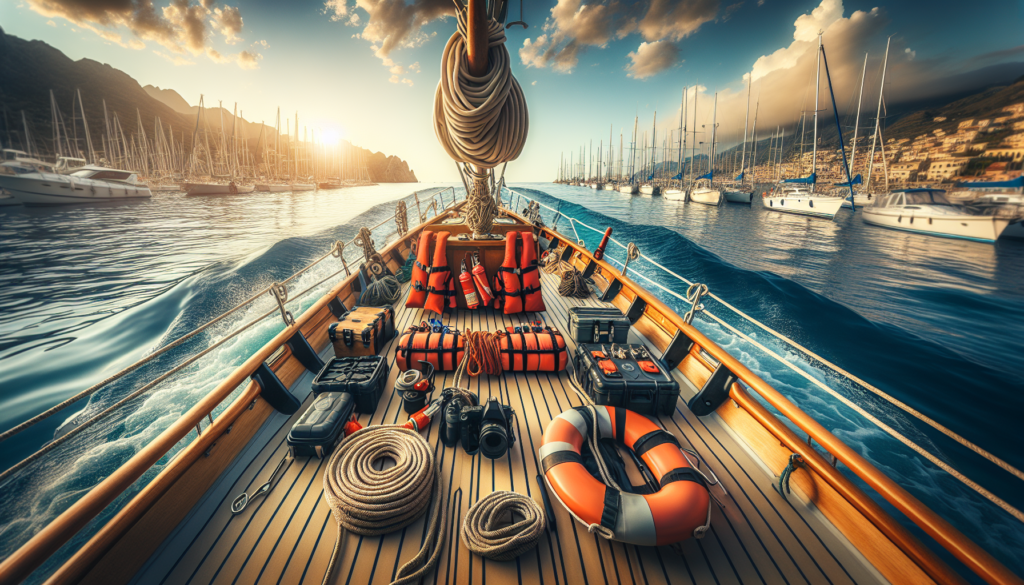Embark on a journey through the waters of knowledge as you navigate the crucial seascape of boating safety. The “Boating Safety Tips for Anchoring and Mooring” article acts like a trustworthy lighthouse guiding you to master the art and finesse integral to anchoring and mooring your vessel. As you dip your oars into these waters, you’ll gather rich insights into everything from setting anchor to identifying suitable mooring points, always ensuring your maritime expedition remains smooth and secure. With these guidelines at your helm, you’re on course to sail through any challenge the waterways might present.

Understanding Anchoring and Mooring
Navigating through the shimmering waters, you’re the captain who must control more than just the steering wheel. Anchoring and mooring are two vital aspects that ensure your vessel remains afloat and in place. Let’s plot our course to understand these concepts.
Definition of Anchoring
Anchoring is a method to secure a floating vessel, like your boat, to the seabed. This technique uses an anchor, a heavy object you lower into the water, which then lodges into the sea floor. Think of it as a temporary parking spot in the waterbody.
Definition of Mooring
Sailing to the shores of the mooring, this technique involves securing your boat to a fixed object. Whether it’s a buoy, pier, or dock, mooring is usually used when the boat will stay put longer. It’s like renting a garage for your boat.
Differences and Similarities between Anchoring and Mooring
Anchoring and mooring may both be about securing your boat, but their execution sets them apart. Anchoring uses the boat’s own gear and creates a temporary hold on the sea floor. Meanwhile, mooring connects the boat to a permanent object or structure. Their similarity lies in offering stability to your boat and peace of mind to you.
Importance of Safe Anchoring and Mooring
A flawless journey across the waves not only requires an able captain but also safely anchored or moored vessels.
Preventing Boat Damage
Imagine your boat crashing against rocks due to poor anchoring or mooring. Scary, isn’t it? Proper anchorage and mooring methods prevent such mishaps, safeguarding your boat from damage.
Ensuring Personal Safety
Safe anchoring and mooring ensure your own safety and that of others on board. A well-anchored boat doesn’t drift, eliminating the risk of accidental collisions or capsizing.
Environmental Consideration
Proper anchoring and mooring techniques also protect the environment. Dropping an anchor randomly can destroy sensitive marine ecosystems. Respect Mother Nature when you drop your hook!
Choosing the Right Anchor
Just as every captain has a favorite sea shanty, every vessel requires the correct anchor.
Types of Anchors
From fluke anchors, plow anchors, to mushroom anchors, your vessel has a diverse line-up to choose from. The right anchor for you will depend on your boat’s size and the maritime conditions you’ll encounter.
Determining the Right Anchor for your Boat
Just like a snugly fit hat, your boat requires an anchor that complements its weight and structure. A heavy boat might need a heavy duty anchor, while a lighter, smaller boat might do well with a modest-sized anchor.
Determining the Right Anchor for the Environment
Environmental factors play a pivotal role in selecting anchors. An anchor meant for sandy bottoms might prove ineffective in rocky seabed.
Anchoring Techniques
Anchoring isn’t just about throwing the anchor out to sea; it’s an artistic technique, almost like a dance with the ocean.
Determining the Right Spot for Anchoring
Your vessel isn’t a leaf to be carried by the wind! Pick an anchoring spot that’s protected from current, wind, and waves, and has enough space for your boat to swing with the tide.
Setting the Anchor
Take a deep breath and lower your anchor without a rush, ensuring it hits the bottom. Reverse slowly to dig or “set” the anchor into the seafloor.
Testing the Anchor Hold
Give the anchor line some tension by reversing slowly. If the boat doesn’t budge, voila, rooted firmly!
Monitoring the Anchored Boat
Regularly check your boat’s position once anchored. It’s best to stay vigilant for any sudden changes.

Safety Precautions While Anchoring
Steer your vessel towards safety while anchoring with these cautious considerations.
Weather Considerations
Always gauge weather conditions before anchoring. In severe weather conditions, seek out the most protected area or consider multiple anchors.
Beware of Surrounding Obstacles
Lookout for any potential obstacles that could entangle your anchor line. Watch out for other vessels, submerged objects, or marked navigational hazards.
Proper Use of Anchor Lines
Ensure you let out enough anchor line or ‘scope’. A common rule is 5-7 times the depth of the water in calm conditions.
Regular Inspection of Anchor Equipment
Periodically check your anchor equipment. Look out for signs of wear and tear and replace parts as necessary.
Mooring Inspections and Maintenance
Give your mooring due consideration and regular maintenance.
Inspecting Mooring Lines
Inspect mooring lines for fraying, wear and tear. The best mooring can fail with a poor line.
Understanding Mooring Load
Understand the load capabilities of your mooring. Overloading can cause mooring failure.
Regular Maintenance of Mooring Gear
Maintain your mooring gear regularly. This includes replacing if required, lubricating moving parts, fixing loose shackles and more.
Replacing Worn out Mooring Equipment
Replace any equipment that shows significant wear and tear. Safeguarding your boat now can save you from expensive repairs later.
Mooring Techniques
Mooring is an operational ballet between your boat, the mooring gear and the marine environment.
Determining the Right Spot for Mooring
Choose a mooring spot that’s safe and secure, taking into account water depths, tides, current and wind directions.
Securing the Boat to the Mooring
Attach the mooring lines to your boat securely. The tighter the connection, the safer your boat.
Monitoring the Moored Boat
Keep an eye on your boat while it’s moored. Check routinely to ensure it hasn’t loosened or moved.
Safety Precautions While Mooring
Carve a safe journey by taking these precautions while mooring.
Weather Considerations
Just like while anchoring, always consider weather forecasts before mooring your vessel.
Beware of Surrounding Obstacles
Stay cautious of your surroundings, keeping an eye out for other boats, underwater hazards, and fixed structures.
Proper Use of Mooring Lines
Use mooring lines of appropriate length and strength. A line too short or weak could spell disaster.
Regular Inspection of Mooring Equipment
Regularly inspect your mooring equipment. Look out for corrosion, wear and tear or any signs that parts need to be replaced.
Emergency Techniques for Anchoring and Mooring
Master these emergency techniques to battle any untoward circumstances while anchoring or mooring.
Setting an Emergency Anchor
Keep a second anchor on board for emergencies. You never know when you might need it!
Releasing a Stuck Anchor
If your anchor gets stuck under a rock or debris, you can use a retrieval buoy or use the boat’s power to pull it free.
Securing Boat in Extreme Weather Conditions
To secure your boat in extreme weather conditions, you may need to use more than one mooring line or even anchor.
Using Mooring Buoys in Emergencies
Mooring buoys can also be a saving grace in emergencies. You can secure your boat to a buoy if it’s strong enough and the weather conditions permit.
Cruising Community Etiquette
Maintaining etiquette while cruising is as important as safe anchoring and mooring.
Respecting Privacy of Others
Just like you, other people enjoy their peace while at anchor. Respect their privacy and do not anchor too close.
Avoiding Damage to Other Vessels
Careful when you’re setting your anchor or mooring. Make sure it doesn’t cause damage to other vessels.
Understanding Local Regulations
Adhere to the local rules and regulations, right from anchoring to mooring, and know the laws of the buoy.
Navigating through this aquatic maze of anchoring and mooring techniques, it is your skill and knowledge that steer the vessel into a secure spot. Happy cruising, captains!


[…] securing your boat against the mighty wind and wild currents but also against the stealthy thief? Advanced anchor systems can reinforce your boat’s position, making it less likely for thieves to unhitch […]
[…] the salty sea air filling your lungs as you guide your vessel towards the harbor. The Importance of Proper Docking and Mooring Techniques whispers secrets of seafaring safety, etiquette, and precision. From the techniques that […]